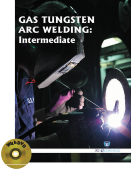Trade and Industrial Education

Gas Tungsten Arc Welding: Intermediate comprehends various diverse practical and visual skills with knowledge of specialized materials and techniques. Gas tungsten arc welding (GTAW) is an arc welding process that uses a non-consumable tungsten electrode to produce the weld. The weld area is protected from atmospheric contamination by an inert shielding gas (argon or helium), and a filler metal is normally used, though some welds, known as autogenous welds, do not require it. This book will introduce the knowledge and skills for those studying and/or working in welding industry to interpret and convey information in response to workplace requirements.
About this Book
This book covers the information consists of basic to core competencies that a person must achieve to weld carbon steel plates and carbon steel pipes components as specified by layout, blueprints, diagrams, work order, welding procedure or oral instructions using GTAW equipment. The book explores the several different types of joints method of welding, including the butt joint, lap joint, corner joint, and t-joint.
About the Gas Tungsten Arc Welding Industry
Tungsten inert gas (TIG) welding or Gas tungsten arc welding (GTAW) is the process of blending together reactive metals, such as magnesium and aluminum. During the welding process, an arc is formed between a pointed tungsten electrode and the area to be welded. A shielding gas is used to help create a clean weld, as it prevents oxidization from occurring. The welding method became popular and useful in the early 1940s and, as a result, has greatly propelled the use of aluminum for welding and structural processes. It is commonly used for both high quality and manual welding. The type of gas shielding typically used for TIG welding is argon, helium, or a combination of both. When combined, these two gases can ensure a higher welding speed and welding penetration. Argon is usually preferred by most welders simply because it is heavier than air and provides better coverage when welding. Using the TIG welding process, a person can perform a variety of weld types on a number of different metals, although steel and aluminum are the most widely used. A filler rod, usually made from the same material as the base metal, is used for reinforcing joints and welding heavy metals. There is also a certain level of skill required for gas welding, to ensure that the weld is flawlessly done. A job as a Gas Welder falls under the broader career category of Welders, Cutters, and Welder Fitters. Welders operate and maintain the machines that fabricate and repair metal structures, equipment and machinery. Welders are qualified for positions in a variety of fields based on their skill level and experience, including shipbuilding, automotive, construction and manufacturing industries. Opportunities are expected to be better for skilled welders trained in the latest technologies due to the difficulty employers are facing finding qualified workers.